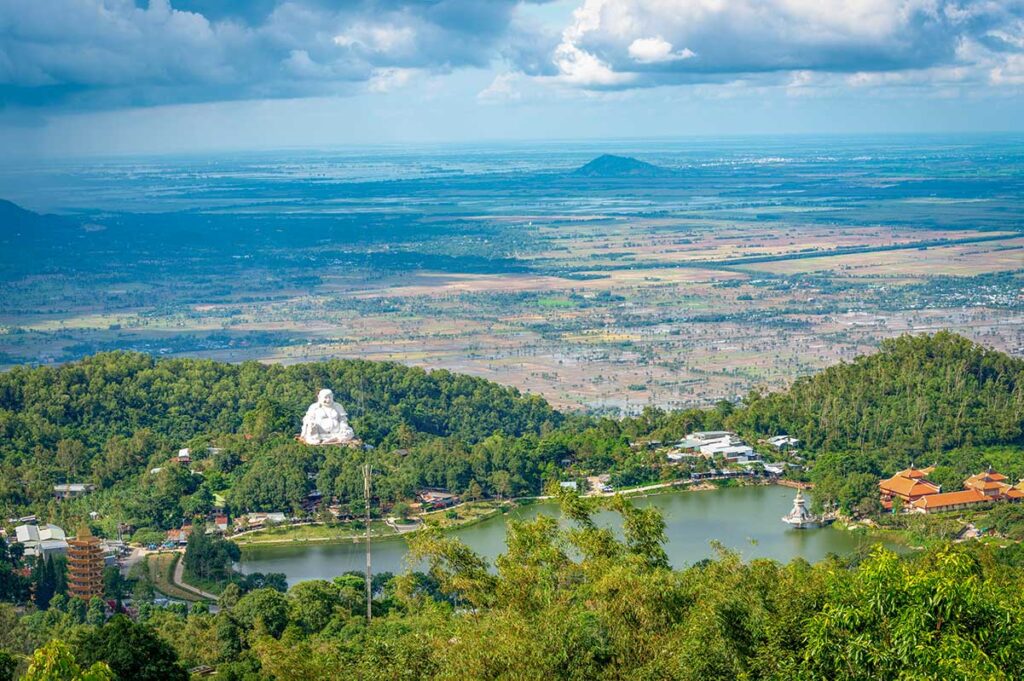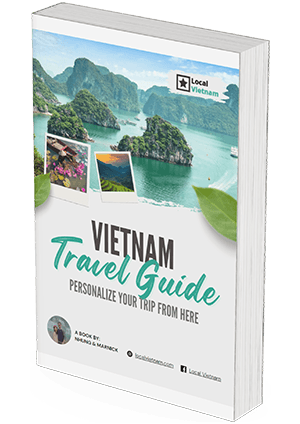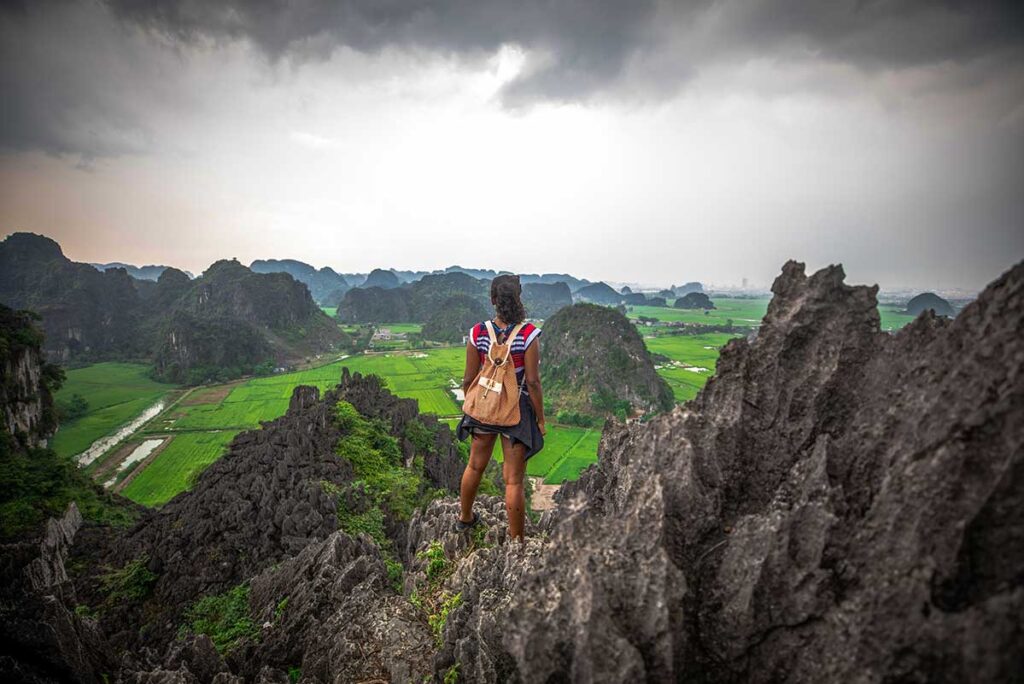What is Cam Mountain?
Cam Mountain, also called Forbidden Mountain, rises from the That Son (Seven Mountains) area in An Giang Province and is the highest peak of the Mekong Delta at about 710 meters. Its altitude brings a refreshing climate unusual for the otherwise flat and hot region, earning it the nickname “Da Lat of the Mekong Delta.”
Today it is both a sacred pilgrimage site and a natural attraction, blending pagodas, shrines, caves, and panoramic views with local legends and spiritual traditions. For travelers, it offers a mix of cultural depth and scenic beauty in one of Vietnam’s most unique corners.
History and Legends
The story of Cam Mountain’s name, “Forbidden Mountain,” goes back to the late 18th century. When Prince Nguyễn Ánh (later Emperor Gia Long) was fleeing the Tây Sơn rebels, he is said to have taken refuge here. To protect his hiding place, officials spread rumors that the mountain was home to demons, poisonous animals, and evil spirits. Locals were warned that entering would bring illness or death, so people stayed away—and the name “forbidden” stuck.
Later, the mountain became an important site for followers of the Bửu Sơn Kỳ Hương Buddhist tradition. Its secluded forests and caves attracted monks and hermits who came here for meditation, giving the place a reputation for spiritual energy.
During the Vietnam War, the mountain’s caves also served as hideouts and bases for resistance forces, adding another layer of historical weight. Alongside these real events, countless legends developed—of sacred wells that never run dry, caves inhabited by spirits, and gods protecting the land. Whether you see them as folklore or faith, they still shape how locals and pilgrims view the mountain today.
Highlights of visiting Cam Mountain Today
1. Cable car ride
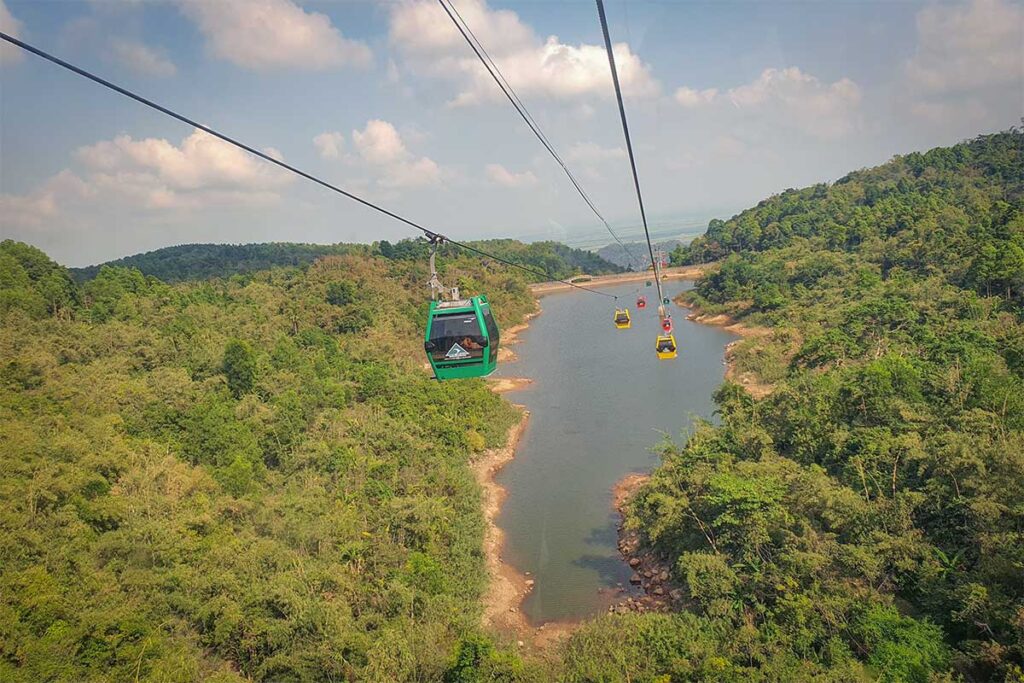
The easiest way to reach the top is by cable car, which cuts the climb down to just a few minutes. Tickets are not cheap by local standards, but they include the entrance fee. The ride is more horizontal than steep, passing over green hillsides and villages, and it gives a nice perspective of the area. The system works fine, though it feels older compared to modern installations elsewhere in Vietnam. Don’t expect luxury cabins, but the views are pleasant enough to make it worthwhile.
2. Maitreya Buddha Statue
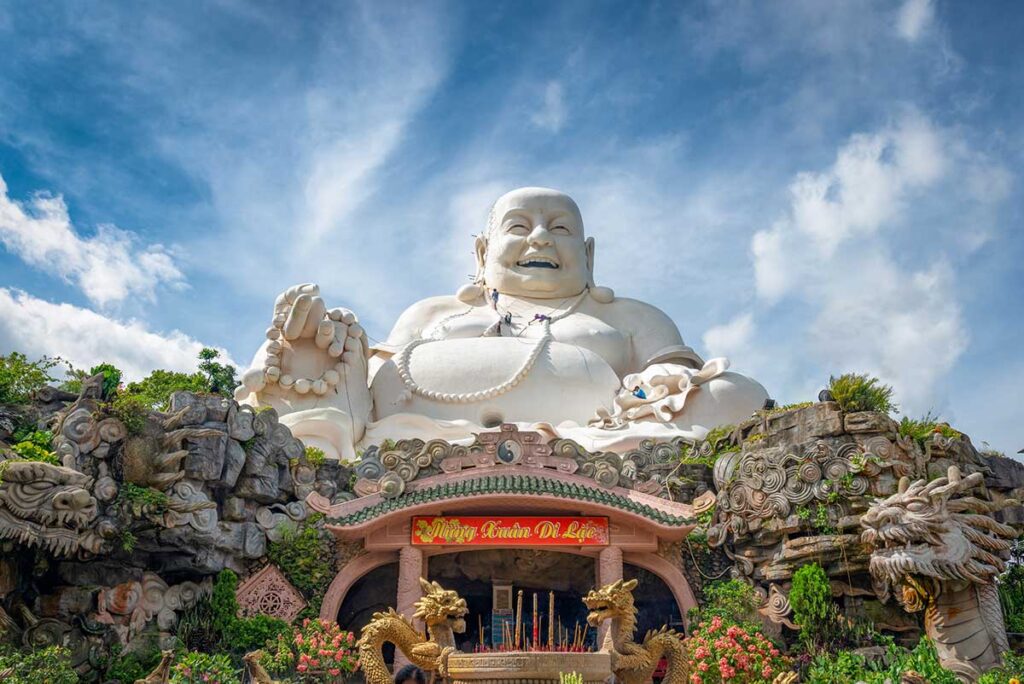
One of the most striking sights is the giant Maitreya Buddha statue, sitting at 33.6 meters high and visible from far across the delta. It is recognized as the largest Maitreya statue in Southeast Asia. For pilgrims, it carries deep spiritual meaning, while for visitors it’s simply an impressive landmark to admire (and photograph). Its scale against the surrounding green hills is part of what makes Cam Mountain memorable.
3. Van Linh Pagoda
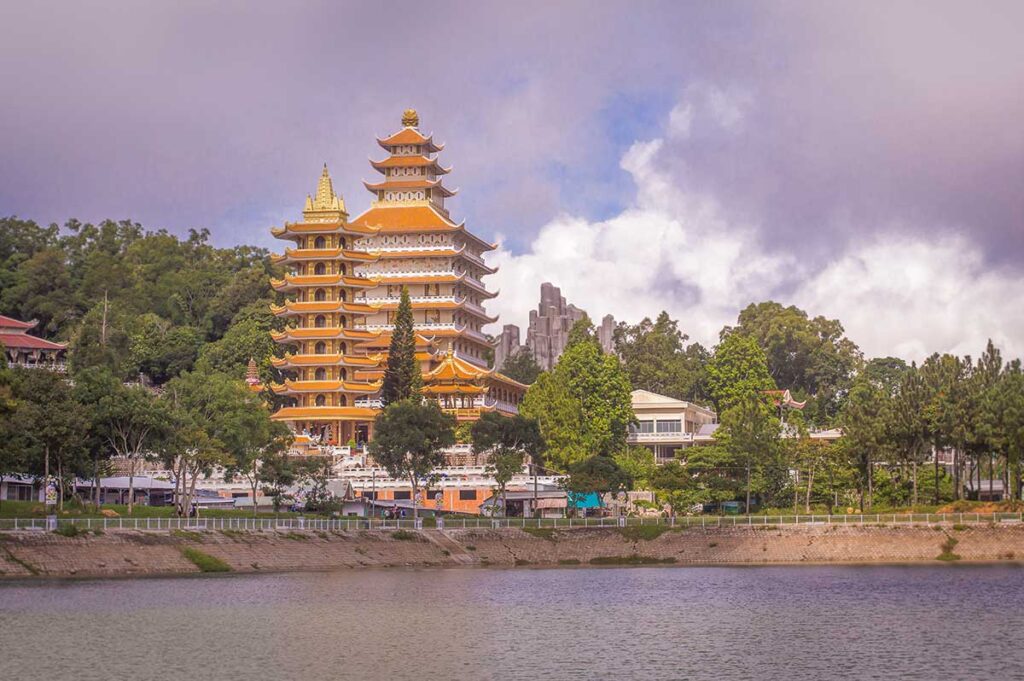
Van Linh Pagoda, rebuilt in the 1990s on the site of an older hermitage, is the most prominent religious site on the mountain. The pagoda complex has distinctive towers with multiple tiers and a peaceful setting among the trees. It’s active with worshippers, so it’s best to walk respectfully and avoid being too intrusive with cameras. The mix of religious architecture and mountain backdrop gives it a calm atmosphere, especially outside of peak festival days.
4. Thuy Liem Lake

In the middle of the tourist area is Thuy Liem Lake, an artificial reservoir surrounded by gardens and coffee shops. It’s not natural, but it does add a relaxed space where visitors can stroll or sit down for a drink. Many pilgrims buy small fish here to release into the lake, a symbolic act of merit. The area can feel busy and commercial, but it’s a decent place to pause before continuing on.
5. Bo Hong Peak (Highest Point)

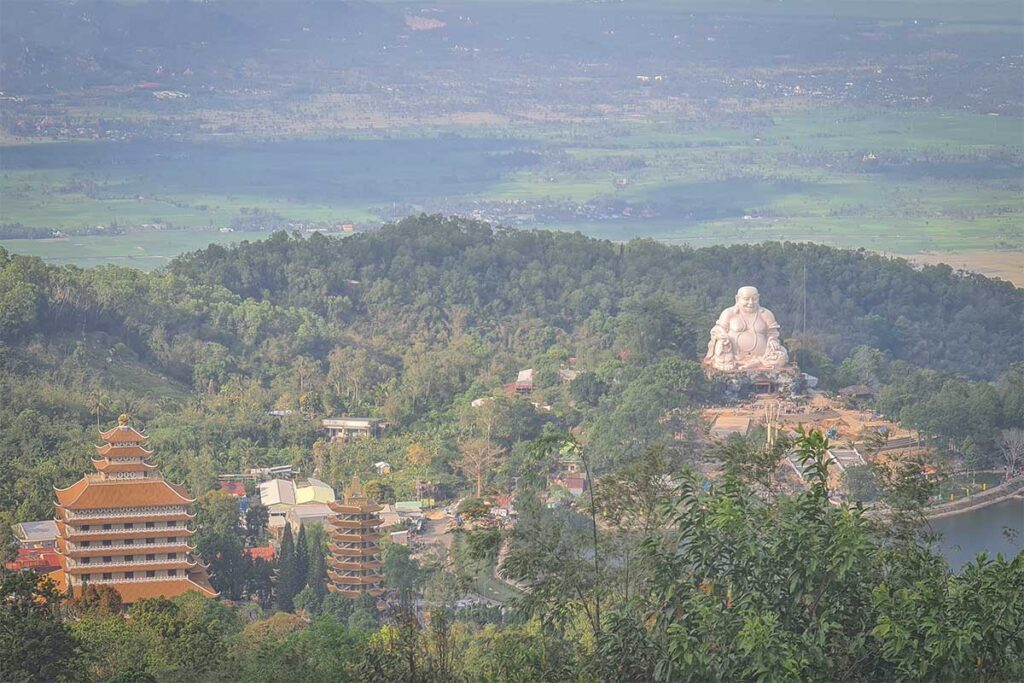
Bo Hong Peak is the highest spot on Cam Mountain and the highest point anywhere in the Mekong Delta. On clear days, you can see rice fields stretching endlessly and even glimpse across the border into Cambodia. Visitors coming by cable car can walk here, while hikers may reach it through forest trails. The view is impressive, though haze often reduces visibility, especially in the hot or rainy months.
6. Other Pagodas, Shrines & Caves
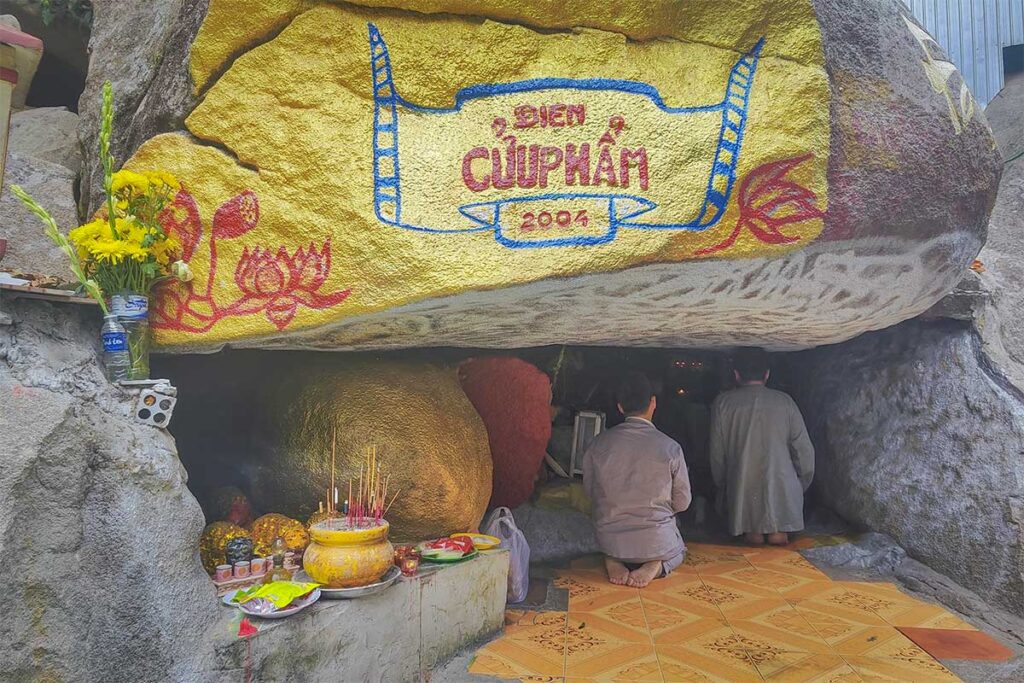
Scattered around the mountain are more places of worship and natural features. The Big Buddha Temple (also called Zen Monastery) houses the giant Buddha image, while smaller shrines like Muoi Co or caves such as Thuy Liem and Ong Ho add variety. Most are modest but collectively contribute to the sacred atmosphere. If you enjoy exploring, you can easily spend a couple of hours moving between them.
7. Nature trails & Trekking
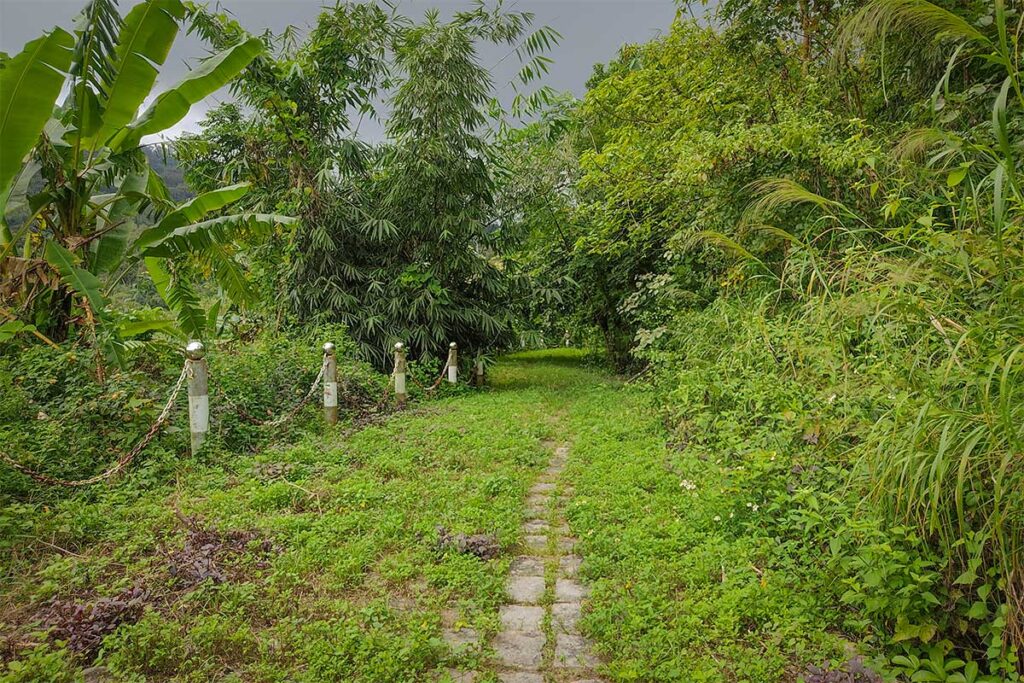
For those who prefer something more active, there are trekking routes that take two to three hours with local guides. The paths pass through patches of forest and quiet streams. It’s a refreshing change of scenery for the otherwise flat Mekong Delta, though if you’ve trekked in northern Vietnam, don’t expect the same drama. Here, the appeal is more about escaping the crowds and enjoying a peaceful walk.
8. Local food & Specialties
Around the lake and pagoda areas, you’ll find food stalls and restaurants offering local specialties. Dishes include free-range mountain chicken, jaggery-based sweets, and pancakes served with wild vegetables. While the setting feels touristy and prices are higher than in nearby towns, it can still be fun to try a few bites. Just don’t expect it to be a culinary highlight of your Vietnam trip.
How to get there
Chau Doc as a Base
The most practical base for visiting Cam Mountain is Chau Doc, a lively riverside town near the Cambodian border. Chau Doc has a range of hotels, from budget guesthouses to comfortable mid-range stays, and it’s well-connected by bus and car.
From Ho Chi Minh City, the journey takes about 6–7 hours by bus or private transfer. From Can Tho, it’s a shorter 3-hour ride, making it a common stop on Mekong Delta itineraries. Chau Doc itself has enough to see—floating villages, markets, and Sam Mountain—that it’s worth staying at least one night.
From Chau Doc to Cam Mountain
Cam Mountain lies about 30 km from Chau Doc, which makes it an easy half-day or full-day excursion. The most convenient option is to hire a private car with driver, especially if you want to combine it with other sights like Tra Su Forest. This way, the driver waits for you and you won’t have to deal with transport issues on the mountain.
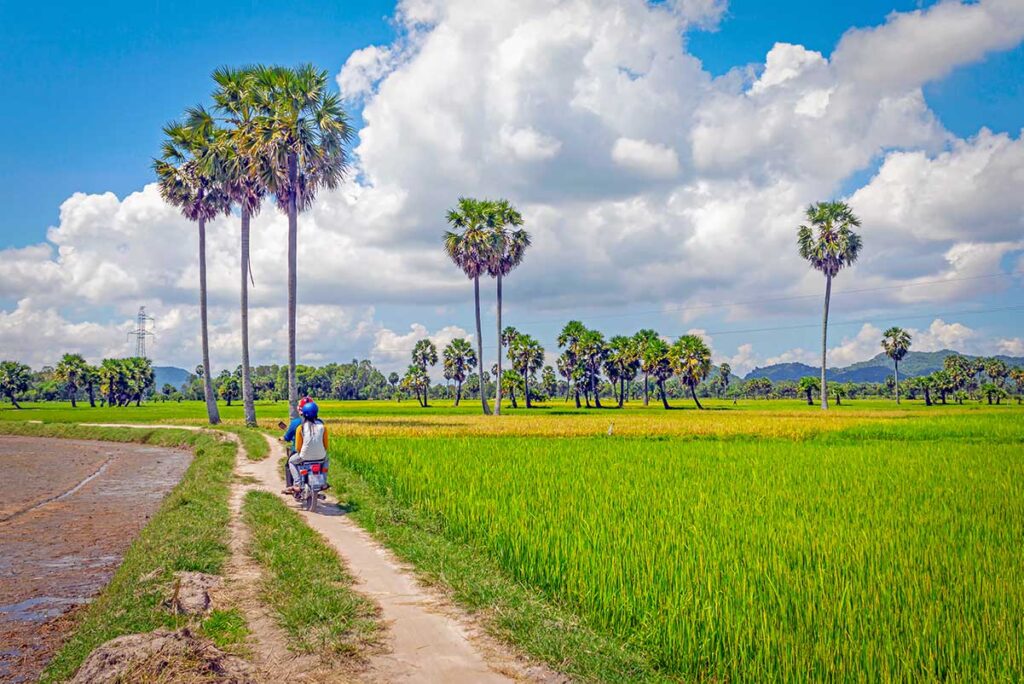
Renting a motorbike is another option if you’re confident on rural Vietnamese roads; the ride itself is scenic and gives you more flexibility. Regular taxis aren’t recommended, as drivers may be reluctant to wait for hours while you explore.
Practical visiting information & Tips
Opening hours & Entrance fees
Cam Mountain is generally open from dawn to dusk, with activity starting early as pilgrims arrive for morning prayers. The entrance fee is included in the cable car ticket. Prices at the time of writing are around 180,000 VND (≈7 USD) for a round-trip adult ticket and 90,000 VND (≈3.5 USD) for children. One-way tickets are slightly cheaper if you prefer to hike one direction.
Best time to visit
Mornings and late afternoons are the best times for clearer views and softer light, while midday can be hot and hazy. The pilgrimage season runs from the 4th to the 7th lunar months (roughly May–August), when the mountain is packed with devotees. If you want a quieter experience, aim for weekdays outside this period.
Crowds & Atmosphere
Expect crowds during Tet (Lunar New Year) and major festivals, when the atmosphere can feel more chaotic than peaceful. Motorbikes are allowed around the summit area, which adds noise and detracts from the serenity. Litter can also be an issue, especially during peak times. If you prefer a calmer visit, timing is key.
Facilities & Services
Food stalls, drink vendors, and souvenir shops are spread around the lake and pagoda areas. Basic guesthouses and hotels exist on the mountain, but the setting feels touristy and not particularly restful compared to staying in Chau Doc. Unless you’re curious about overnighting on the mountain, most travelers will be more comfortable basing themselves in town.
Dress & Etiquette
As Cam Mountain is primarily a religious site, dress respectfully: shoulders and knees covered when entering pagodas or shrines. Comfortable footwear is essential, whether you’re trekking or just walking between attractions, as there are many steps and uneven paths. A light scarf can be useful for both modesty and sun protection.
Is Cam Mountain worth visiting?
Cam Mountain is certainly one of the more unusual sights in the Mekong Delta. It offers a mix of spiritual atmosphere, mountain scenery, and religious landmarks that you won’t find in the otherwise flat delta. The giant Maitreya Buddha, the cool breeze at the summit, and the chance to explore pagodas and shrines make it a worthwhile stop if you’re already in An Giang.
That said, it isn’t Vietnam’s most polished or peaceful attraction. The summit area can feel overly touristy, with shops, motorbikes, and litter taking away from the mountain’s natural charm. For most travelers, it’s best visited as part of a broader trip that also includes Chau Doc, Tra Su Forest, or the surrounding countryside. On its own, it may not justify the journey, but combined with other highlights it can add variety and depth to your Mekong Delta experience.
